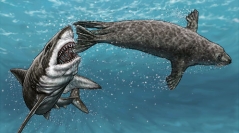

 Comptes Rendus Palevol
23 (8) - Pages 107-118
Comptes Rendus Palevol
23 (8) - Pages 107-118There are now many examples in the fossil record of shark bite marks preserved on biogenic materials including coprolites, ammonoids, sea star ossicles, an echinoid, and bone and calcified cartilage. These exceptional fossils document evidence of exploratory behavior, active predation, and/or scavenging. However, only a small subset report on the presence of shark teeth embedded in fossilized bone or cartilage. Although a few shark tooth-marked seal bones are known from the fossil record, no direct evidence of predation or scavenging in the form of a shark tooth embedded in a fossil seal bone has yet been documented. Herein, we describe the first shark tooth embedded in a seal (Phocidae Gray, 1821) bone, a calcaneum (CMM-V-6964), that was surface collected in Mosaic’s South Fort Meade Mine, Hardee County, Fort Meade, Florida, United States. The isolated bone originated from within the Bone Valley Member of the Peace River Formation (Hawthorn Group). The partial tooth is identified as having come from an Early Pliocene great white shark, Carcharodon carcharias (Linnaeus, 1758). This discovery also represents the first C. carcharias tooth ever found embedded in a fossil bone. The embedded tooth may have come about as a result of active predation or scavenging. The extant macropredatory sharks, Carcharodon carcharias (great white shark), Notorynchus cepedianus (Péron, 1807) (sevengill shark), Somniosus microcephalus (Bloch & Schneider, 1801) (the Greenland shark), and Somniosus antarcticus Whitley, 1939 (sleeper shark), are known to actively prey upon seals (Pinnipedia Illiger, 1811). If this peculiar fossil association resulted from active predation, the seal did not survive the encounter because there is no evidence of healing in the area around the embedded shark tooth.
Seal calcaneum, white shark tooth, trophic interaction, bite marks, morderolite, Neogene